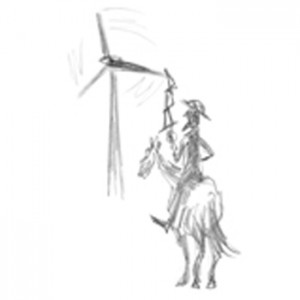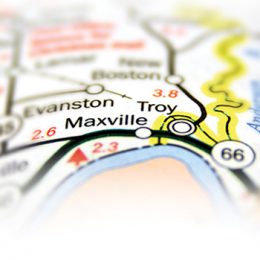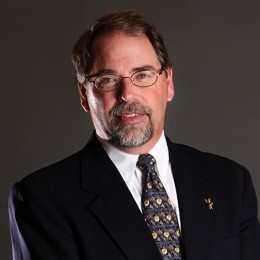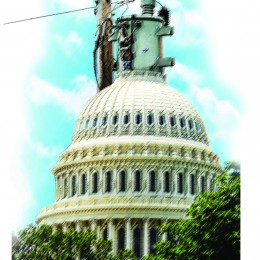 Don Quixote is a popular figure from literature, art, stage and screen. The fictional knight-errant personifies chivalry and idealism.
Don Quixote is a popular figure from literature, art, stage and screen. The fictional knight-errant personifies chivalry and idealism.
The stories go that Quixote, an eccentric country gentleman, set aside sanity to sally forth on a quest to make the world a better place. From Broadway’s adaptation of the Cervantes character came the inspirational tune, “The Impossible Dream.”
But Quixote is also synonymous with kooky. He tilted at windmills thinking they were giants and believed a barber’s washbasin was a golden helmet with special powers.
Don Quixote must be riding again. Crusades to raise up just the renewable energy sources in climate change initiatives sound more than just optimistic. They are incredibly quixotic. Folks are tilting toward wind turbines and other renewables while proposing bans on coal-fired power. These are simple answers to the problematic and complex climate projections looming before us. But to those in the electric cooperative industry dedicated to keeping lights on and rates reasonable for all of our members, many of these proposals are impossible dreams.
At the National Rural Electric Cooperative Association’s annual meeting in March came sobering talk — straight talk — from NRECA’s CEO Glenn English and keynote speaker James Woolsey, the former CIA director.
English said there is a “reality gap” between what folks in the media, public and Congress think renewable energy can deliver and what it can actually do. He noted we all wish wind and solar power could be this “silver bullet” to meet all of our energy needs and cut carbon emissions. But the reality is they simply cannot replace coal at this time.
Yes, renewables must be developed, improved and deployed. But there are still many uncertainties and inefficiencies. Wind turbines placed where the wind blows best generate electricity at only about 40 percent capacity on average. When the wind doesn’t blow or the sun doesn’t shine, there is no wind or solar power. Coal provides 50 percent of the nation’s electricity; it can’t be dismissed and replaced over night. In fact, English pointed to a recent report from MIT that said if this nation is going to keep the lights on, it’s going to need more coal-fired generation.
Meeting our nation’s energy demands while reducing carbon dioxide emissions is going to take a realistic, balanced, systemic approach phased in over time.
Both English and Woolsey talked about a portfolio, a mix of solutions from an array of existing and promising new technologies over the next 20 years, to meet these challenges. In addition to capturing carbon, the nation is also going to have to add more nuclear capacity which produces no greenhouse gases.
English praised a seven-pronged plan, what he called a “practical road map,” recently introduced by the Electric Power Research Institute, a nonprofit research group in Palo Alto, Calif. The plan calls for:
- Increasing energy efficiency in homes, building and industry;
- Boosting deployment of cost-effective large-scale renewable energy resources;
- Continuing the operation of all existing nuclear generating plants and adding substantial new generation by 2020;
- Improving the efficiency of new coal-based power plants;
- Deploying carbon dioxide capture and storage technologies at most new coal-based generating plants by 2020;
- Accelerating the wide-scale adoption of “plug-in” hybrid electric vehicles;
- Expanding distributed energy resources, including solar photovoltaic.
English noted co-ops are already heading down many of these roads. The nation’s electric co-ops for years have sought — in the words of Broadway’s Quixote —“treasure where there is only trash” by capturing and converting waste landfill gas to electricity and promoting other biomass projects. Some 88 percent of the nation’s electric co-ops offer renewables in their power portfolios. Some 11 percent of co-op power nationwide is renewable or hydropower. Co-ops also have invested in energy efficiency and conservation programs and clean coal technologies.
Electric co-ops know all about what some called “impossible dreams” and overcoming challenges. They are the legacies of Franklin Roosevelt’s New Deal, electrifying the 70 percent of the nation’s landmass where other power companies dared not go. And they’ll answer the clarion calls on climate change.
But one lesson from Don Quixote: falling for fantasies while ignoring reality eventually leads to disillusionment and failure. Our nation faces incredible challenges of keeping the lights on and electric rates affordable amid growing global energy demand and environmental concerns. We must not fail in meeting these challenges.
We need Quixote’s indignation and idealism to spur and inspire us. But we also need to keep a grip on reality and first reach for the reachable stars.
To learn more about MIT’s report on coal, click here.



